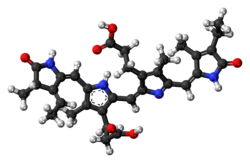Phycocyanobilin

| |

| |
| Names | |
|---|---|
| IUPAC name
3-[(2Z,5E)-2-[[3-(2-carboxyethyl)-5-[(Z)-[(3R,4R)-3-ethyl-4-methyl-5-oxopyrrolidin-2-ylidene]methyl]-4-methyl-1H-pyrrol-2-yl]methylidene]-5-[(4-ethyl-3-methyl-5-oxopyrrol-2-yl)methylidene]-4-methylpyrrol-3-yl]propanoic acid
| |
| Identifiers | |
| |
3D model (JSmol)
|
|
| 4285356 | |
| ChEBI | |
| ChemSpider | |
PubChem CID
|
|
| |
| |
| Properties | |
| C33H38N4O6 | |
| Molar mass | 586.69 g/mol |
Except where otherwise noted, data are given for materials in their standard state (at 25 °C [77 °F], 100 kPa). | |
| Infobox references | |
Phycocyanobilin is a blue phycobilin, i.e., a tetrapyrrole chromophore found in cyanobacteria and in the chloroplasts of red algae, glaucophytes, and some cryptomonads. Phycocyanobilin is present only in the phycobiliproteins allophycocyanin and phycocyanin, of which it is the terminal acceptor of energy. It is covalently linked to these phycobiliproteins by a thioether bond.
Phycocyanobilin, PCB, has the ability to bind to human serum albumin, HSA, protein found mainly in the blood of humans. This PCB-HCA complex benefits the structure of HSA, increasing the thermal stability of HSA, as well as increasing its ability to prevent against proteolytic activity of other proteins.[1]
References[]
- ^ Radibratovic M, Minic S, Stanic-Vucinic D, Nikolic M, Milcic M, Cirkovic Velickovic T (2016-12-13). "Stabilization of Human Serum Albumin by the Binding of Phycocyanobilin, a Bioactive Chromophore of Blue-Green Alga Spirulina: Molecular Dynamics and Experimental Study". PLOS ONE. 11 (12): e0167973. Bibcode:2016PLoSO..1167973R. doi:10.1371/journal.pone.0167973. PMC 5154526. PMID 27959940.
Further reading[]
- Cole WJ, Chapman DJ, Siegelman HW (1967). "Structure of phycocyanobilin". Journal of the American Chemical Society. 89 (14): 3643–3645. doi:10.1021/ja00990a055. ISSN 0002-7863.
Categories:
- Photosynthetic pigments
- Tetrapyrroles
- Biochemistry stubs